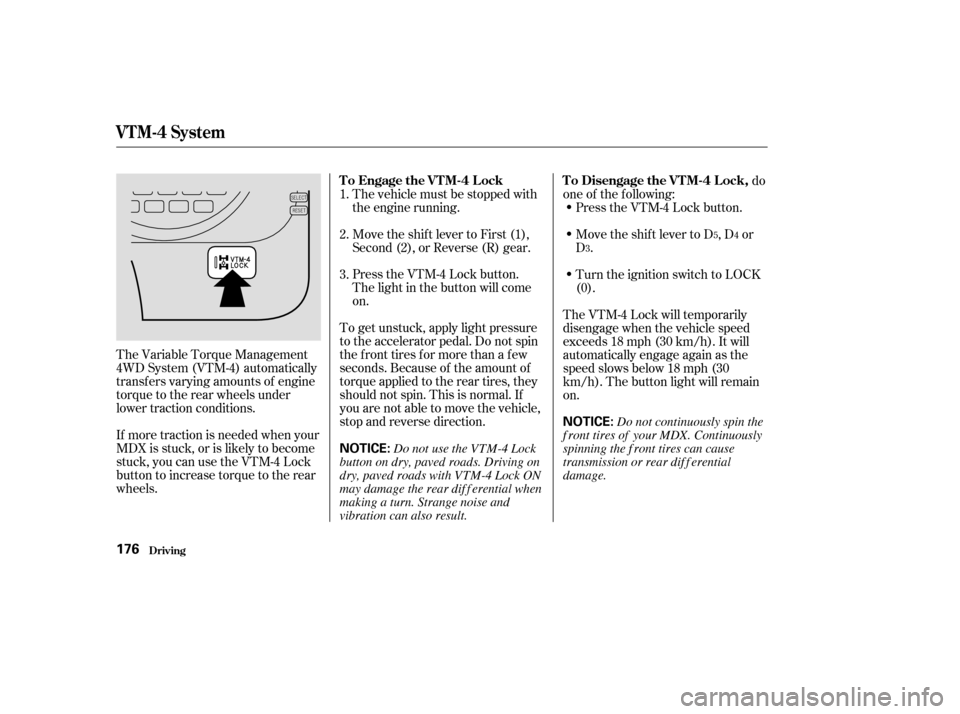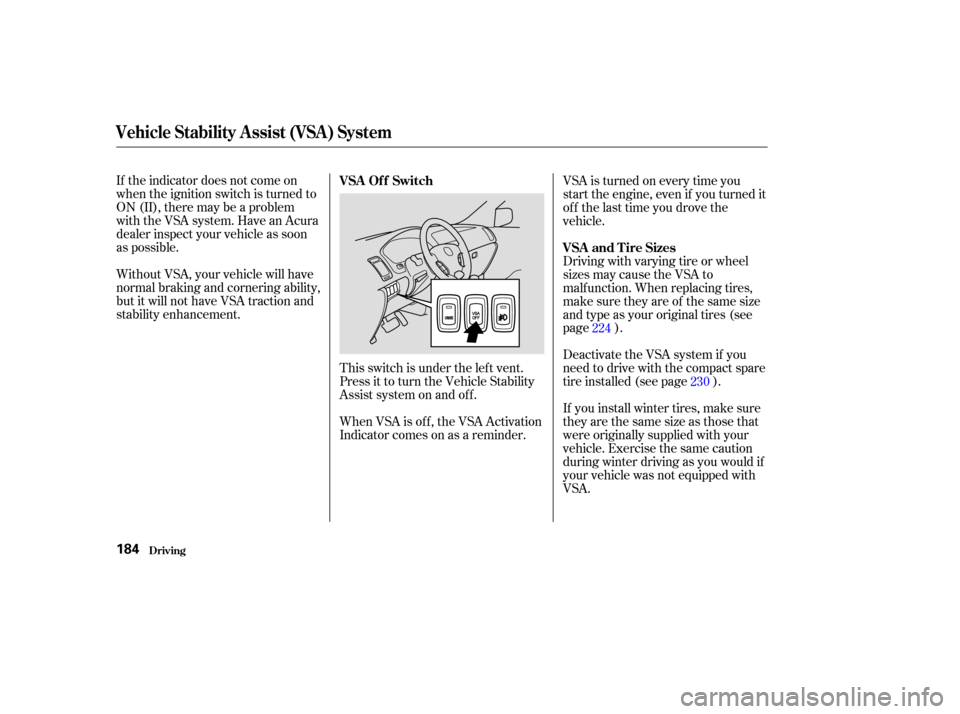engine Acura MDX 2004 Owner's Guide
[x] Cancel search | Manufacturer: ACURA, Model Year: 2004, Model line: MDX, Model: Acura MDX 2004Pages: 284, PDF Size: 3.92 MB
Page 180 of 284

The Variable Torque Management
4WD System (VTM-4) automatically
transf ers varying amounts of engine
torque to the rear wheels under
lower traction conditions.
If more traction is needed when your
MDX is stuck, or is likely to become
stuck, you can use the VTM-4 Lock
button to increase torque to the rear
wheels.The vehicle must be stopped with
the engine running.
Move the shift lever to First (1),
Second (2), or Reverse (R) gear.
Press the VTM-4 Lock button.
The light in the button will come
on.
To get unstuck, apply light pressure
to the accelerator pedal. Do not spin
the f ront tires f or more than a f ew
seconds. Because of the amount of
torque applied to the rear tires, they
should not spin. This is normal. If
you are not able to move the vehicle,
stop and reverse direction. do
one of the f ollowing: Press the VTM-4 Lock button.
Move the shift lever to D , D or
D.
Turn the ignition switch to LOCK
(0).
The VTM-4 Lock will temporarily
disengage when the vehicle speed
exceeds 18 mph (30 km/h). It will
automatically engage again as the
speed slows below 18 mph (30
km/h). The button light will remain
on.
1.
2.
3.
54
3
To Engage the VTM-4 Lock To Disengage the VTM-4 Lock,
VTM-4 System
Driving176
NOTICE: NOTICE:
Do not use the VTM-4 Lock
button on dry, paved roads. Driving on
dry, paved roads with VT M-4 Lock ON
may damage the rear dif f erential when
making a turn. Strange noise and
vibration can also result. Do not continuously spin the
f ront tires of your MDX. Continuously
spinning the f ront tires can cause
transmission or rear dif f erential
damage.
Page 181 of 284

Your Acura is equipped with a Tire
Pressure Monitoring System
(TPMS) that turns on every time you
start the engine and monitors the
pressure in your tires while driving.
Each tire has its own pressure
sensor. If the air pressure of a tire
becomes signif icantly low, the
sensor in that tire immediately sends
a signal that causes the low tire
pressure indicator and the
appropriate tire on the Tire Pressure
Monitor to come on.Driving on a signif icantly under-
inf lated tire causes the tire to
overheat and can lead to tire failure.
Under-inf lation also reduces f uel
efficiency and tire tread life, and may
af f ect the vehicle’s handling and
stopping ability.
When the tire pressure monitoring
system warning light is lit, one or
more of your tires is signif icantly
under-inf lated. You should stop and
check your tires as soon as possible,
and inflate them to the proper
pressureasindicatedonthevehicle’s
tire inf ormation placard. Each tire, including the spare should
be checked monthly when cold and
set to the recommended inf lation
pressure as specif ied in the vehicle
placard and owner’s manual (see
page ).
Although your tire pressure is
monitored, you must manually check
thetirepressuresmonthly.
If you think you can saf ely drive a
short distance to a service station,
proceed slowly to the station and
inflate the tire to the recommended
pressure shown on the driver’s
doorjamb.
If the tire is f lat, or if the tire
pressure is too low to continue
driving, replace the tire with the
compact spare tire.
222
Tire Pressure Monitoring System (TPMS)
Driving
Low Tire Pressure
Indicator
177
Page 184 of 284

Resting your f oot on the pedal keeps
the brakes applied lightly, builds up
heat, and reduces their ef f ectiveness.
It also keeps your brake lights on all
the time, conf using drivers behind
you.
Constant application of the brakes
when going down a long hill builds
up heat and reduces their ef f ective-
ness. Use the engine to assist the
brakes by taking your f oot of f the
accelerator and downshif ting to a
lower gear.Check the brakes after driving
through deep water. Apply the
brakes moderately to see if they f eel
normal. If not, apply them gently and
f requently until they do. Be extra
cautious in your driving.
The hydraulic system that operates
the brakes has two separate circuits.
Each circuit works diagonally across
the vehicle (the lef t-f ront brake is
connected with the right-rear brake,etc.). If one circuit should develop a
problem, you will still have braking
at two wheels.
If the brake pads need replacing, you
will hear a distinctive, metallic
screeching sound when you apply
the brake pedal. If you do not have
the brake pads replaced, they will
screech all the time. It is normal f or
the brakes to occasionally squeal or
squeak when you apply them.
Your vehicle is equipped with disc
brakes at all f our wheels. A power
assist helps reduce the ef f ort needed
on the brake pedal. The ABS helps
you retain steering control when
braking very hard.
Braking System DesignBrake Wear Indicators
Braking System
Driving180
Front
Page 187 of 284

The Vehicle Stability Assist system
helps to stabilize the vehicle during
cornering if the vehicle turns more
or less than desired. It also assists
you in maintaining traction while
accelerating on loose or slippery
road surf aces. It does this by
regulating the engine’s output, and
by selectively applying the brakes.
When VSA activates, you may notice
that the engine does not respond to
the accelerator in the same way it
does at other times.
The VSA system cannot enhance the
vehicle’s driving stability in all
situations and does not control your
vehicle’s entire braking system. It is
still your responsibility to drive and
corner at reasonable speeds and to
leave a sufficient margin of safety.When VSA activates, you will see the
VSA Activation indicator blink.
If the VSA system indicator comes
on while driving, pull to the side of
theroadwhenitissafe,andturnoff
the engine. Reset the system by
restarting the engine. If the VSA
system indicator stays on, or comes
back on while driving, have the VSA
system inspected by an Acura dealer.
CONT INUED
VSA A ctivation Indicator
VSA System Indicator
Vehicle Stability Assist (VSA) System
Driving183
Page 188 of 284

If the indicator does not come on
when the ignition switch is turned to
ON(II),theremaybeaproblem
with the VSA system. Have an Acura
dealer inspect your vehicle as soon
as possible.
Without VSA, your vehicle will have
normal braking and cornering ability,
but it will not have VSA traction and
stability enhancement.This switch is under the lef t vent.
Press it to turn the Vehicle Stability
Assist system on and of f .VSA is turned on every time you
start the engine, even if you turned it
off the last time you drove the
vehicle.
Driving with varying tire or wheel
sizes may cause the VSA to
malf unction. When replacing tires,
make sure they are of the same size
and type as your original tires (see
page ).
Deactivate the VSA system if you
need to drive with the compact spare
tire installed (see page ).
If you install winter tires, make sure
they are the same size as those that
were originally supplied with your
vehicle. Exercise the same caution
during winter driving as you would if
your vehicle was not equipped with
VSA.
When VSA is off, the VSA Activation
Indicator comes on as a reminder. 224
230
VSA Of f Switch
VSA and Tire Sizes
Vehicle Stability Assist (VSA) System
Driving184
Page 194 of 284

When driving with a f ix-sided (e.g.
camper, utility) trailer, do not
exceed 55 mph (88 km/h). At
higher speeds, the trailer may
sway or affect vehicle handling.
Whenbeingpassedbyatruckor
large vehicle, cross-winds and air
turbulence can disrupt your
steering and cause your trailer to
sway. Keep a constant speed, steer
straight ahead, and do not try to
make quick steering or braking
corrections.
Do not park on an incline unless it
is unavoidable. If you must, turn
the vehicle’s wheels toward the
curb on a downhill or away f rom
the curb on an uphill. Af ter
parking, place wheel chocks at
each trailer tire on the downhill
side.Always drive slowly and have
someone guide you when backing up.
Grip the of the steering
wheel; then turn the wheel to the lef t
to get the trailer to move to the lef t,
andturnthewheelrighttomovethe
trailer to the right.
If the vehicle’s wheels slip when
retrieving a boat f rom the water,
shif t to f irst gear, and turn on VTM-4
Lock (see page ). Disengage
VTM-4 Lock as soon as the boat is
out of the water to prevent damage
to the VTM-4 system.
When climbing hills, closely watch
your temperature gauge. If it nears
the red (Hot) mark, reduce speed
and, if necessary, pull to the side of
the road and let the engine cool.
If the transmission shif ts f requently
while going up a hill, shif t down one
gear.
If youmuststopwhenfacinguphill,
use the f oot brake or parking brake.
Do not try to hold the vehicle in
placebypressingontheaccelerator,
this could cause the automatic
transmission to overheat.
When driving down hills, reduce
your speed and shif t down to D . Do
not ‘‘ride’’ the brakes.
176
bottom
3
Backing Up
Ret rieving a Boat Driving on Hills
Towing a Trailer
Driving
Remember it
will take longer to slow down and
stop when towing a trailer.
190
Page 195 of 284

Your MDX can be towed behind a
motorhome at legal highway speeds
up to 65 mph (100 km/h). Do not
exceed 65 mph (100 km/h) or severe
transmission damage will occur. To
avoid damage to the 4WD system, it
must be towed with all f our wheels
on the ground (f lat towing).
When purchasing a tow bar, make
sure you select a reputable
manuf acturer. Follow the
manufacturer’s attachment
instructions caref ully.
Perf orm this procedure every day
immediately bef ore you begin towing.
Otherwise, severe automatic
transmission damage will occur.Start the engine. Check the transmission f luid level
(see page ). Press on the brake pedal. Shif t the
lever through all the positions (P,
R,N,D,D,D,2,1).
ShifttoD ,thentoN.Letthe
engine run f or three minutes, then
turn it off.
Release the parking brake.
Leave the ignition switch in the
ACCESSORY (I) position so the
steering wheel does not lock.
Make sure the radio and any items
plugged into the accessory power
sockets are turned of f so you do
not run down the battery.
If you tow more than 8 hours in one
day, you should repeat the above
procedure at least every 8 hours
(when you stop f or f uel, etc.)
210
543 5
Ext ended T owing
Towing Your Vehicle Behind a Motorhome
Driving191
NOTICE: T he steering system can be
damaged if the steering wheel is locked.
Leave the ignition switch in the
ACCESSORY (I) position, and make
sure the steering wheel turns f reely
bef ore you begin towing.
Page 197 of 284

Before you leave the pavement, be
sure to do all scheduled maintenance
and service and that you inspect your
vehicle. Pay special attention to the
condition of the tires and check the
tire pressure.
After you return to the pavement,
caref ully inspect your vehicle to
make sure there is no damage that
could make driving it unsaf e.
Recheck the condition of the tires
and the tire pressure.
The route presents limits (too steep
or bumpy roads). You have limits
(driving skill and comf ort). And your
vehicle has limits (traction, stability,
and power).
Driving of f -highway can be
hazardous if you f ail to recognize
limits and take the proper
precautions.Forbettertractiononallsurfaces,
accelerate slowly and gradually build
up speed. If you try to start too fast
on wet soil, mud, snow, or ice, you
might not have enough traction to
get underway and you may dig
yourself a hole. Starting with the
shif t lever in second gear (2) will
help you have a smoother start on
snow and ice.
Keep in mind that you will usually
need more time and distance to
brake to a stop on unpaved surf aces.
Avoid hard braking. Do not pump
the brakes; let the anti-lock braking
system pump them f or you.
Debris in the road can damage your
suspension or other components.
Because your vehicle has a high
center of gravity, driving over a large
obstacle, or allowing a wheel to drop
into a deep hole can cause yourvehicle to tip or roll over.
If you can’t clearly see all road
conditions or obstacles, walk the
slope bef ore you drive on it. If you
have any doubt whether or not you
can saf ely drive on the slope, don’t
do it. Find another route.
Bef ore driving through water, stop
and make sure that:
The water is not deep enough to
cover your wheel hubs, axles or
exhaust pipe. You could stall and
not be able to restart your engine.
The water can also damage
important vehicle components.
If you are driving up a hill and f ind
that you cannot continue,
. Your vehicle could roll
over. Slowly back down the hill,
f ollowing the same route you took up
the hill.
do not try to
turn around
Check Out Your Vehicle
Remember: Accelerating and Braking
Avoiding ObstaclesDriving on Slopes
Crossing a Stream
Of f -Highway Driving Guidelines
Driving193
Page 198 of 284

The banks are sloped so you can
drive out.
The water is not f lowing too f ast.
Deep rushing water can sweep you
downstream. Even very shallow
rushingwatercanwashthe
ground f rom under your tires and
cause you to lose traction and
possibly roll over.
The banks and surf ace under the
water provide good traction. The
water may hide hazards such as
rocks, holes, or mud.
If you decide it is saf e to drive
through water, choose a suitable
speed and engage the VTM-4 Lock.
Proceed without shif ting or changing
speeds, and do not stop the vehicle
or shut of f the engine.
After driving through water, test
your brakes. If they got wet, gently
pump them while driving slowly until
they operate normally. If the water is deeper than the wheel
hubs, some additional service may
be required. This service is not
covered by your warranties.
If you get stuck, engage the VTM-4
Lock (see page ). Caref ully try to
go in the direction (f orward or
reverse) that you think will get you
unstuck. Do not spin the tires at high
speeds. It will not help you get out
and may cause damage to the
transmission or VTM-4 system.
If you are unable to f ree yourself ,
your vehicle is equipped with f ront
and rear tow hooks designed f or this
purpose.
Use a nylon strap to attach the MDX
to the recovery vehicle and caref ully
take out the slack in the strap. Once
the strap is tight, the recovery
vehicle should apply f orce.
Remember that the recovery vehicleneeds good traction to avoid
becoming stuck, too.
You should never use a jack to try to
get unstuck. Your vehicle could
easily slip of f the jack and hurt you
or someone else.
You may be able to safely tow a
lightweight trailer (such as a
motorcycle or small tent trailer) of f -
road if you f ollow these guidelines.
Do not exceed 1,000 lbs (450 kg)
or a tongue weight of 100 lbs (45
kg).
Trytostayonsmooth,leveldirt
roads, and avoid driving in hilly
terrain.
Allow extra room f or starting,
stopping, and turning.
Slow down if you encounter bumps
or other obstacles.
176
If You Get Stuck
Towing a Trailer Off-Road
Of f -Highway Driving Guidelines
Driving194
Page 199 of 284

This section explains why it is
important to keep your vehicle well
maintained and how to f ollow basic
maintenance saf ety precautions.
This section also includes
Maintenance Schedules f or normal
driving and severe driving conditions,
a Maintenance Record, and instruc-
tions f or simple maintenance tasks
you may want to take care of
yourself .
If you have the skills and tools to per-
f orm more complex maintenance
tasks on your Acura, you may want
to purchase the Service Manual. See
page f or inf ormation on how to
obtain a copy, or see your Acura
dealer.......................
Maintenance Saf ety .196
.................
Maintenance Schedule . 197
....................
Maintenance Record .201
..............................
Fluid Locations .204
........................
Adding Engine Oil .205
.........
Changing the Oil and Filter . 206
..............................
Engine Coolant .208
....................
Windshield Washers .209
....
Automatic Transmission Fluid . 210
..........................
Dif f erential Fluid .211
.............
Transf er Assembly Fluid . 211
....................................
Brake Fluid .212
....................
Power Steering Fluid . 213
....................................
Timing Belt .213
....................................
Hood Latch .214
.............................................
Lights .214
.......................................
Seat Belts .218
.....................................
Floor Mats .218
.................................
Wiper Blades .219
...............................................
Tires .221
...................
Checking the Battery . 226
.............................
Vehicle Storage .227
269
Maintenance
Maint enance195